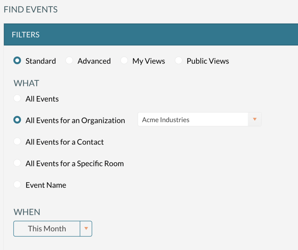Life would be easier for you, and your customers would have a better experience, if they would just use your online request form. But they don’t. Why not? In most cases, it’s because they think the form is hard to understand, takes too long to complete, or both.
Customers may also feel that you’re asking for information that isn’t relevant to the type of event they’re scheduling. Or, you may not have tested your form properly and solicited feedback, and consequently it just doesn’t work well.
So, rather than using the form, customers call or email you when they want to book space in your facility. Neither of those contact methods is as efficient as making an online request. Phone calls can be particularly problematic, as they interrupt your team when they’re working on other tasks and can really hurt your department’s productivity.
Other problems caused by your customers’ refusal to use your online request form include:
- Information gathered on the phone or in email doesn’t have the structure that your request form has, so it’s often incomplete or incorrect.
- Your team frequently has to spend time tracking down the customer for clarification.
- There’s no audit trail when information provided via phone or email is subsequently modified.
The good news is that you can “rehab” your form’s image and get more people to use it.
Proven Tips for Increasing Online Reservation Request Form Adoption
Based on the problem(s) your online request form has, use the strategies below to fix what’s broken and make using it a more appealing option.
Your form is not intuitive.
People are willing to use your form, they just get confused by it.
- Ensure that your request form is designed with your audience in mind. If you’re frequently dealing with people who’ve never made a reservation request before, your form will have to be much simpler than if your average customer is an experienced event organizer. (Forms created using Mazévo can accommodate anyone from novice to advanced users.)
- Provide ways for people to get help quickly while working on a form.
You’re asking for information that isn’t relevant.
Event organizers get frustrated by questions that don’t pertain to them.
- Revisit your request form from the perspective of what matters to people making requests. For example, say people scheduling fundraisers must be asked what the funds are for and encouraged to read your fundraiser policies. If someone is scheduling an event that is not a fundraiser, they shouldn’t be bothered with those items.
- Capitalize on Mazévo’s question-triggering capability. The system can pose questions to all requesters, or it can present them based on defined event attributes.
Location: These questions are displayed if a user requests space in specific places.
Service: These questions are displayed if a user selects a certain service (AV, catering, etc.).
Manual: An event planner manually enters a response to these questions.
Attendance: These questions are displayed if the event's attendance is equal to or greater than the value entered.
Event type: These questions are displayed if a user selects a particular event type.
Organization type: These questions are displayed if the organization selected by the user for the event matches the selected types.
- Use dependent questions—meaning those that are only asked if appropriate based on the answer to a prior question. For instance, only ask about food allergies if the organizer has answered “Yes” to the question “Will your event have catering?”
You haven’t done enough testing on your form.
If your scheduling department has implemented an online request form without sufficiently testing it, you’re not alone. This “set it and forget it” approach to online request functionality is common—and it’s understandable, given how hectic work can be for scheduling pros.
- Schedule a time to “refresh” your form, being sure to test it thoroughly before you relaunch it.
- Set a reminder to review the form on a regular basis and tweak it to ensure it stays in synch with customer needs and your scheduling processes.
An Easier Way to Reach Out
Even after you’ve fine-tuned your online request form, there will be times when you need to contact an event organizer to get more information or clarification on details they’ve provided. When that’s the case, Mazévo’s helpful messaging feature is a great way to reach out to them. It lets you communicate with organizers quickly and efficiently in a mode that’s similar to texting or using chat messages.
Ultimately, improving how you handle requests benefits everyone involved—your customers, your team, and any third-party service providers.
For more insights on streamlining your request process, download our Ultimate Guide to Meeting Room Requests. We’re also happy to answer any questions you have. Contact us at 800-254-7615 or schedule an informative online demo.



